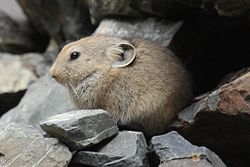Ecology
Distribution and habitat
O. p. pallasi can be geographically separated from the other three subspecies. O. p. pallasi is largely distributed in Kazakhstan and the other large group O. p. pricei, are distributed along Mongolia and bordering territories. [5] The range for both these groups extends all the way between the Betpak Dala Desert located in Kazakhastan to the Helan Shan Range. The remaining two, which have been little-studied, O. p. argentata collected mostly at the Helan Shan Range and the O. p. sunidica found mostly near the Chinese-Mongolian border, both of which found in rocky habitats with very restricted ranges. [5]
Diet
Pallas's pikas are much smaller in body size than other herbivores that usually share the same environment. Their body size allows them to consume more of the lower level vegetation, giving them more of an advantage over larger herbivores, such as livestock. [3] Like other pikas, Pallas's pika is herbivorous and saves grass in the summer to eat in the winter. They often construct haypiles with this stash, but some populations prefer to keep their stores under rocks. Their diet consists mostly of grasses, however their diet does range in flowers as well as stems. [3] Like all lagomorphs (rabbits, hares, pikas), Pallas's pika creates, expels & eats cecotropes (cecotrophy) to get more nutrition from its food. [3]
Ecosystem roles
Pallas's pika mostly are found in more arid type climates. They have shown to play a role in not only seed dispersal and vegetation, but the alteration of site conditions. [6] This alteration through burrowing, has led to plant growth and increased soil nutrients. This is a clear representation of allogenic ecosystem engineering. [6]
Phylogeny and taxonomy
There are four defined taxa: O. p. pallasi, O. p. pricei, O. p. sunidica, and O. argentata. [4] Mitochondrial studies show that the two larger defined taxa of O. pallasi are paraphyletic to O. argentata. [4] However, morphometric data shows that the taxa O. p pricei and O. p. pallasii show similar traits to one other than to O. argentata. O. argentata differ in that they show a rufous type coloration in the summer and a more silver type coloration in the winter. [4]
As a species, Pallas's pika is common. However, O. p. hamica, O. p. helanshanensis and O. p. sundica are rated as "critically endangered" and "endangered", respectively, on the IUCN Red List.
This page is based on this
Wikipedia article Text is available under the
CC BY-SA 4.0 license; additional terms may apply.
Images, videos and audio are available under their respective licenses.


